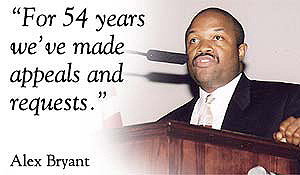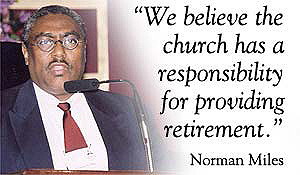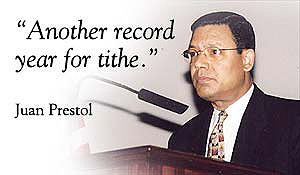BY CARLOS MEDLEY
 hen more than 320 Adventist administrators, pastors, lay
members, and teachers, gathered for the North American Division Executive Committee�s
year-end meetings October 29-November 1, committee members faced some of the
same issues that confronted them one year ago�-wages for pastors and teachers,
and denominational retirement.
hen more than 320 Adventist administrators, pastors, lay
members, and teachers, gathered for the North American Division Executive Committee�s
year-end meetings October 29-November 1, committee members faced some of the
same issues that confronted them one year ago�-wages for pastors and teachers,
and denominational retirement.
Convening at the Adventist world headquarters in Silver Spring,
Maryland, this year�s council was the first meeting chaired by the division�s
new president Donald Schneider, who was elected at the General Conference session
in Toronto this past July. During year-end meeting division leaders vote church
policies, elect departmental leaders, hear reports, and approve the division�s
annual budget.
Salary Update
The executive committee was updated on many wage-related
challenges facing educational institutions and local conferences. According
to church leaders, faculty members on Adventist campuses are leaving their positions
in large numbers. Some officials report that it�s much more difficult to attract
K-12 and higher education teachers because of the growing wage gap between Adventist
institutions and public colleges and schools. NAD vice president Richard Osborn
reported that there is also a serious shortage of Adventist professors with
doctoral degrees.
On the other hand, some local conferences have had a difficult
time in paying pastors� salaries at the official denominational wage scale.
Meanwhile, several church entities including church-related health care institutions,
Adventist Risk Management, some colleges and universities, and one publishing
house, have already departed from the denominational wage system.
Pacific Union president Tom Mostert, who had chaired the
division�s Remuneration Strategy Taskforce for more than a year before resigning
that post, told the executive committee that some taskforce members, mostly
administrators, felt they were in a serious conflict of interest in discussing
wage scale. �The committee thought it might be good to reconfigure the group,
bringing in more lay members, perhaps even a majority of lay members and a lay
chair.�
One major complication in the wage issue is the fact that
the denomination�s salary structure is very compressed, with only about 12 percent
difference between the average ordained pastor and General Conference president
(excluding cost of living adjustments for living expenses in different regions
of North America). At the same time, many Adventist college professors who are
paid within the denominational range often incur thousands of dollars in debt
to earn advanced degrees, making it difficult to live on denominational salaries.
Higher Ed High Wire
Some educational administrators say that faculty salaries
should not be tied to ministerial wages. �It seems to me that the problem is
not just how much one is paid but how one is paid,� said Malcolm Maxwell, retiring
Pacific Union College president.�� �The effort to tie everybody�s salary close
to the pastor�s wage sometimes leads to a distortion in the process.�
�Virtually all pastors rise to the top level of pay in five
or six years after being employed by the conference,� Maxwell explained. �On
the other hand, only 30 percent of college and university teachers ever get
top pay. One reason is that you must have a doctorate. The average time for
a doctorate in the United States is five-and-a-half years following college.
When you get right down to it, is the thing that holds us together an identical
pay scale, or is what holds us together a common commitment to Jesus Christ
and the mission He has given us?�
College and university administrators had prepared a proposal
that would have moved to put faculty salaries in line with other regional Christian
schools. However, this proposal was delayed so the remuneration taskforce could
study it.
Sounding a note of concern over the length of the process,
Garland Dulan, an associate director of the General Conference Education Department,
told the committee, �The problem I see is that there seems to be no sunset on
when these discussions will end. If the decisions regarding education need to
wait until the decisions regarding ministry are resolved, is there any indication
as to when the discussions will end so a decision can be made and both can move
forward?�
Despite the lengthy process, Southern California Conference
president Larry Caviness expressed appreciation for the dialogue. �I appreciate
the fact that we are keeping the remuneration discussion on the table,� he said.
�Our pastors and teachers are eagerly awaiting some word. They know this discussion
is happening and they are awaiting some response on this.�
 Central California Conference president Jerry Page underscored
the need for flexibility in the church�s pay scale.� �We need more differentials
within the wage scale, but my appeal is for a cap somewhere. We need a cap that
we build our differentials under.
Central California Conference president Jerry Page underscored
the need for flexibility in the church�s pay scale.� �We need more differentials
within the wage scale, but my appeal is for a cap somewhere. We need a cap that
we build our differentials under.
�I think we are getting to [a place] in the church where
the word on the street is that the only way to make change in the church is
to ignore policies voted in this room. I don�t think that�s how we are going
to go forward in Jesus� work in North America. We have to stick together. Have
the discussions here. Have our task forces follow it through and then make decisions
that we stick with.�
Retirement Alternative
One day before the discussion on salaries, the presidents
of eight of the division�s nine predominantly Black (or Regional) conferences
presented the group�s intention to pull out of the church�s retirement program
and establish an alternative retirement plan for their employees.�
The town-hall-style dialogue was opened with an overview
of the church�s retirement plan by Don Schneider (see adjacent article, �A Defining
Moment�). After the selected speakers made their presentations, questions were
entertained from the floor. However, no actions were voted.
 Central States president Alex Bryant pointed out that several
Regional conferences were paying into the church�s retirement plan at a much
higher rate than they should have, given the number of Regional employees deriving
benefits from the plan. The Regional presidents decided to press the issue last
year when the North American Division voted to change from its defined benefits
pension plan to a defined contribution plan. The changeover took effect January
1. Church retirees are drawing benefits from the old �frozen� plan while denominational
employees are accruing benefits under the new plan.
Central States president Alex Bryant pointed out that several
Regional conferences were paying into the church�s retirement plan at a much
higher rate than they should have, given the number of Regional employees deriving
benefits from the plan. The Regional presidents decided to press the issue last
year when the North American Division voted to change from its defined benefits
pension plan to a defined contribution plan. The changeover took effect January
1. Church retirees are drawing benefits from the old �frozen� plan while denominational
employees are accruing benefits under the new plan.
Since the beginning of the year, the eight Regional conferences
have withheld approximately $7 million from the new plan. Under church policy,
each conference sends nine percent of tithe to the retirement fund regardless
of the number of retired employees it has. In 1999, according to information
shared with the committee, Lake Region Conference paid in $900,000 while its
retirees drew out less than $300,000 in the same period. And Central States
Conference recently paid in $300,000 while its retirees drew out only $60,000.
All conferences pay more than the actual costs to fund their
own employees. The overage helps to pay benefits for expatriate employees and
institutional workers. However, Regional presidents believe their overpayments
have been extreme, considering that only four percent of denominational retirees
on the plan come from Regional conferences and Oakwood College.
�In the 1940s, Frank Jones, Northeastern Conference treasurer,
registered concerns about the inequities of the retirement plan,� Bryant said.
�For years we were providing retirement dollars for jobs that Blacks had no
access to. For 54 years we�ve made appeals and requests. We�ve come to a point
that we cannot go down this path any longer.�
 Lake Region Conference president Norman Miles, who also chairs
the Regional presidents' caucus, said the Black presidents turned thumbs down
on the new plan because it shifts the responsibility of investment to the employee.
�We believe the church has the responsibility of providing retirement as an
employee benefit. Also it is difficult for Regional workers to� accumulate enough
money for an adequate retirement under the new plan.�
Lake Region Conference president Norman Miles, who also chairs
the Regional presidents' caucus, said the Black presidents turned thumbs down
on the new plan because it shifts the responsibility of investment to the employee.
�We believe the church has the responsibility of providing retirement as an
employee benefit. Also it is difficult for Regional workers to� accumulate enough
money for an adequate retirement under the new plan.�
In addition to the Regional presidents� objections to the
church�s defined contribution plan, Miles said that the old �frozen� plan did
not provide an adequate income level for retirees who have given 40 years of
continual service. He also noted that the �frozen� plan was not fully funded
and required continued contributions.
Miles outlined an alternative plan that the Regional conferences
are working on. Once this plan takes effect, Regional conferences
would not continue contributing to the old plan at the nine percent rate as
called for under church policy. However, they have requested a study to determine
an equitable share of the liability of the �frozen� plan. �Once we determine
what is an equitable portion, the Regional conferences will assume our share,�
Miles said.
Mardian Blair, a retired health system administrator who
set up the church�s health care retirement plan, told the committee that determining
the fair share for each church entity is extremely complex. �The problem is
that there are other conferences that are in the same exact position as the
Regional conferences.�
NAD president Donald Schneider stated that the issue of retirement
was probably the single most troubling issue that he has faced since elected
to the presidency back in July. However, he emphasized that division officials
and the Regional presidents will continue to dialogue.
New Growth
In his secretary�s report Harold Baptiste declared that membership
in the Seventh-day Adventist Church in North America surpassed the 900,000 mark with total members
at 914,106 as of December 31, 1999. The 914,106 membership total is up four
percent over the previous year. In the first six months of 2000, membership
reached 922,917. These members worship in 4,766 churches and 444 companies.
During 1999 the division added more than 41,000 new members,
the largest total within the past five years, Baptiste said. The total number
of new members for the past five years reached nearly 188,000.
Baptiste told the committee that the General Conference had
reduced the tithe percentage it required local conferences to remit, which will
free more money for local initiatives. He said the greatest benefit derived
from increased funds would be the revitalization of evangelism. �Growth in evangelism
justifies all other growth,� he said.
Dollars and Sense
NAD treasurer Juan Prestol reported that gross tithe for
1999 totaled $610,215,571, an increase of $40,501,497 or 7.1 and 24.1 percent
over the past five years. The gain represents a new record high for tithe and
the sixth consecutive annual increase.
 For the first nine months of this year North American tithe
totaled $437,986,160, up 4.5 percent from the same period in 1999.
For the first nine months of this year North American tithe
totaled $437,986,160, up 4.5 percent from the same period in 1999.
Prestol said that 30 local conferences reported tithe gains
of seven percent or more. Southern Union led the division in total tithe with
$124,319,932 while Southwestern Union led division in membership and tithe growth.
Along with an increase in members, per capita tithe in 1999
also increased to $693.56, up from the previous year. The figure is the highest
within the past five years.
Next year�s division budget will total $68,170,278, a nine
percent decrease compared with this year�s budget. Prestol says the decreased
budget occurred because local conferences will be keeping a larger percentage
of their tithe.
_________________________
Carlos Medley is the Adventist Review news and online editor.

